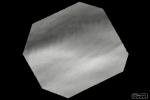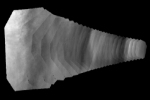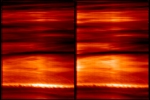No. 35 - Mission Commissioning Results Review
Report for Period 2 July to 8 July 2006During the reporting period the mission operations have been conducted according to plan. The ground and the space segment performance have been nominal with the exception of the mission data system. The Mission Control System (MCS) problems raised by the integration of the latest version have now been largely resolved.
The table below shows a chronology of the main activities in the reporting period:
| MET (Day) |
Date |
DOY |
VPER# |
Main Activity |
| 236 |
02/07/06 |
183 |
72 |
Routine science operations |
| 237 |
03/07/06 |
184 |
73 |
Routine science operations |
| 238 |
04/07/06 |
185 |
74 |
Routine science operations |
| 239 |
05/07/06 |
186 |
75 |
Routine science operations |
| 240 |
06/07/06 |
187 |
76 |
Routine science operations |
| 241 |
07/07/06 |
188 |
77 |
Routine science operations |
| 242 |
08/07/06 |
189 |
78 |
Routine science operations |
At the end of the last Cebreros pass in the reporting period (DOY 189, 14:00) Venus Express was orbiting Venus at 212 million km from the Earth. The one-way signal travel time was 709 seconds.
Payload Activities
ASPERA
The instrument is regularly operated.
MAG
The instrument is regularly operated as part of the routine plan.
PFS
The instrument is currently OFF and is not included in the routine planning. Any further attempt to move the scanner is now suspended until further notice.
SPICAV
The instrument is regularly operated as part of the routine plan.
VeRA
The USO is powered but unmuted. Next operations are already prepared for the start of the Earth occultation season.
VIRTIS
The instrument is regularly operated as part of the routine plan.
VMC
The instrument is regularly operated as part of the routine plan.
Science Results
|
Instrument: VMC
Distance: 39 100 to 22 600 km
Description: This false colour movie was built with ultraviolet images taken at 365 nanometres on 22 May 2006, while Venus Express was flying over the northern hemisphere approaching the planet. |
 |
|
Instrument: VMC
Distance: 39 100 to 22 600 km
Description: This greyscale movie was built with ultraviolet images taken at 365 nanometres on 22 May 2006, while Venus Express was flying over the northern hemisphere approaching the planet. |
 |
|
Instrument: VMC
Distance: 7505 - 1570 km
Description: Movie built with ultraviolet images taken on 24 April 2006. Ultraviolet markings on the cloud top, caused by as yet unidentified UV absorbers, are visible as darker features. |
 |
|
Instrument: VMC
Distance: 7505 - 1570 km
Description: Mosaic of images taken at 365 nanometres on 24 April 2006, flying over the northern hemisphere. |
 |
|
Instrument: VMC
Distance: ~ 66 500 km
Description: Venus's southern hemisphere, observed in the ultraviolet at 365 nanometres. Near the pole, spiralling clouds are observed surrounding the polar vortex. |
 |
|
Instrument: VIRTIS
Distance: ~ 64 000 km
Description: Close-up view of Venus's south polar vortex at three infrared wavelengths, corresponding to different atmospheric depths. The difference in contrast and structure is readily apparent. |
 |
|
Instrument: VIRTIS
Distance: ~ 64 000 km
Description: Movie of close-up images of the double-eyed south polar vortex taken at 5.05 μm. This wavelength reveals cloud structure at ~59 kilometres altitude. |
 |
|
Instrument: VIRTIS
Distance: ~ 64 000 km
Description: Movie showing the same region over the south polar vortex but at different infrared wavelengths between 4.5 and 5.1 μm, allowing to see emission from different altitudes. |
 |
|
Instrument: VIRTIS
Description: Large map of Venus's night side, as observed at 1.7 μm on 12 April 2006, during Venus Express's first orbit around the planet - capture orbit. These type of images are used for measuring the wind speed. |
 |
|
Instrument: VIRTIS
Distance: 6000 - 20 000 km
Description: Composite of two images taken at 2.3 μm (left) and 1.7 μm (right) showing fine atmospheric structure below the Venusian cloud deck. |
 |
|
Instrument: VIRTIS
Distance: 6000 - 20 000 km
Description: Geographical projection of a set of observations at 1.7 μm. The difference in observing distances is reflected in the level of observed detail. |
 |
|
Instrument: ASPERA
Description: The left plot shows the heated solar wind (protons and alfa-particles), which just passed the Venus bow shock. The right plot shows massive escape of planetary oxygen ions. |
 |
Mission Commissioning Results Review
The MCRR concluded successfully on 4 July, and the Board Report has been published. The Review recommendations include several points relevant for future operations, among which are:
- Implementation of onboard thermal monitorings via Service 12 to increase safety of the spacecraft. As well, additional attitude profiles and recovery times have been implemented by Flight Dynamics
- Definition of a new set of attitude constraints derived from VMC's higher than expected sensitivity to Sun radiation (TBC pending further analysis)
- On PFS, the Board recommended to perform new tests, in principle scheduled for the next months, to further investigate the problem with the currently blocked scanner
Future Milestones
Operations for the next weeks have been duly planned and the routine science phase will continue according to the plan. Activities of Medium Term Planning 003 will start now with great focus on the Earth occultations season that starts on 11 July and will continue till the end of August. Several radio science observations have been planned and their commands generated for this time frame.
The updated spacecraft attitude constraints are being reviewed in view of a further optimisation of the science planning. This activity targets to have them operational for the activities of Medium Term Planning 8 (the 4th quarter of 2006).
Last Update: 1 September 2019









